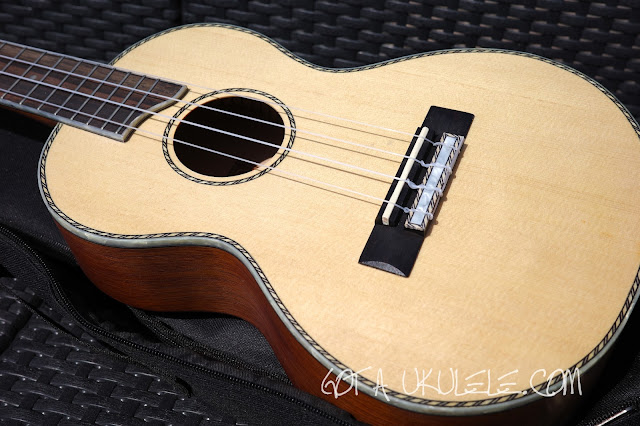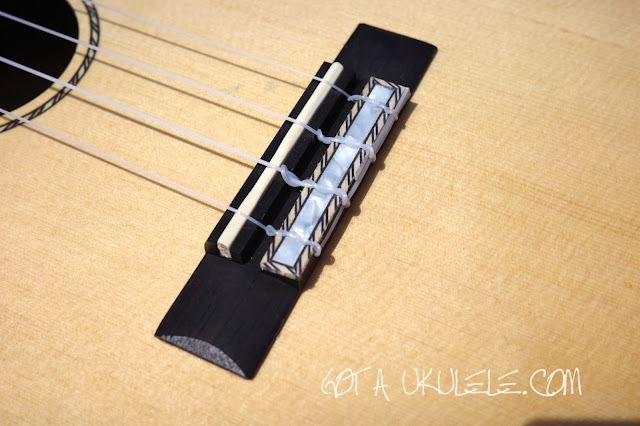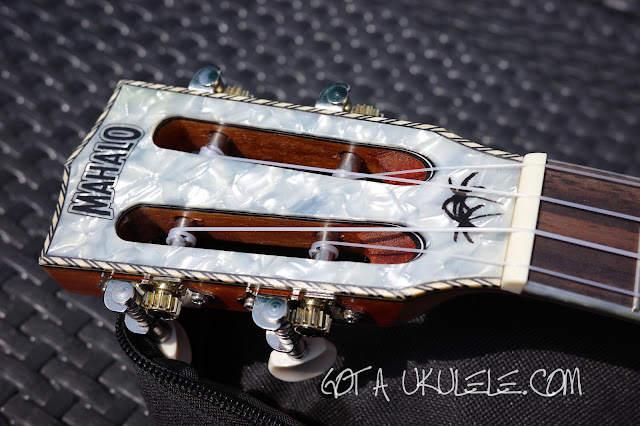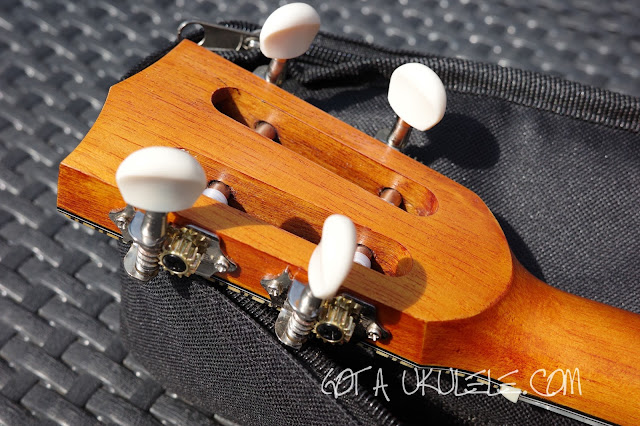A somewhat unexpected return for Mahalo on Got A Ukulele this week - this is their MP3 Pearl Tenor Ukulele.
Some back story here, if a little lengthy... Mahalo are a very well known brand to me, not least because about 15 years back, before I even started writing this website, Mahalo were really one of the only 'value' uke brands available in the UK outside of Kala / Ohana (or spending Hawaiian money). The choice back then was truly limited and I made the fatal mistake of ' buy cheap / buy twice' with my first ever uke ( a Mahalo). The very thing I try to tell people to avoid - I fell into the trap! It was hideous, some frets were set on an angle and it could well have put me off uke for life. I kicked myself but wanted to stick to ukulele and bought a Flea - and that whole experience really led to Got A Ukulele existing as I then used it as a voice to advise other newbies on what to avoid. In a way that terrible Mahalo is WHY this site exists. Back then Mahalo were renowned for the brightly coloured cheap sopranos that I think they still make. I've never been a fan, though did look at a couple of others over the years and was similarly unimpressed. This one was bought by me on request from a few readers, so I will give it a fair crack of the whip and see if things have improved.
And from the off, this is a very different animal to previous Mahalo instruments i've had on review. It's cheap but not 'cheap as chips', it's not brightly painted and it actually has some solid wood in the construction. Surprising, and I think is the first Mahalo I have looked at with any solid wood in it.
It's a standard double bout shaped tenor uke that uses two pieces of solid Sitka spruce on the top and paired pieces of laminate mahogany for the back and sides. It's a classic combination for sure that allows the darker mahogany tones to balance out the brightness of spruce. It must be said though, the spruce here is NOT the highest grade at all. The grain lines are quite variable and wavy in places rather than the tight straight lines of higher grade spruce. There are also some marks in the wood under the satin coating which draw your eye on the otherwise flat colour of the top. These are not just wood imperfections, but in part look like stains or just grubby smudges that sit under the satin so impossible to polish out. Still, this is a 'value' instrument I guess. The back wood , in contrast, whilst laminate has some interesting stripe and a touch of flame to it, even if the single side pieces are rather boring.
The bridge is a tie bar made of Amara Ebony - the variety with more colour variation than the African version. That's surprising to see though and it's pretty tidy too. It's also fitted with an incredibly gaudy decor strip to hide the dowel pins composed of plastic pearl and rope marquetry edging. There's quite a bit more of that 'spangle' to come but the clue here is in the model name! It's fitted with a 45mm string spaced compensated saddle made from NuBone.
Decoration takes a step into the next gear on the top edging. We have some inlaid rope marquetry around the top edge and the sound hole ring which is well done. I just wish they had stopped there as there is also a strip of cheap looking plastic pearl edge binding around the top which is really not to my taste in the slightest. I understand of course that this is a personal thing so if you are into your 'rhinestone' look, you might enjoy it. There is 'mother of pearl' and then there is 'mother of toilet seat'. This is the latter. The body is then finished in a satin coat which seems very thin and, aside from the marks under the coating on the top I mention above, seems even and tidy.
Inside is interesting in many ways. Firstly, it's far tidier than I have seen before from Mahalo with clean notched kerfing and shaped braces. The top brace near the soundhole is drilled through, Kanile'a style to keep strength whilst losing weight. The bridge plate is odd though in the sense it takes up so much space - looking like it covers the space from the bridge right up to the brace. Why you would want so much support in that resonant area is beyond me. Fear of the top splitting?
The neck is made of mahogany in three pieces. The joint in the headstock is well hidden, the one in the heel less so, though I have seen worse. On the heel cap is more plastic pearl with an 'oh so Hawaiian' palm tree emblem. Unsurprisingly for Mahalo it tapers down to a rounded profile and very average 35/6mm nut width (27mm G to A). It's not a neck I would choose but you may disagree.
It's topped with more Amara wood for the fingerboard which seems to be in decent condition and shows off the stripe that this variety of Ebony is famous for. It has a bit of interesting shaping at the end too. It's fitted with 18 frets joined at the 14th and they are dressed right on the edge of not being massively sharp, though you can still feel them. That's not a case of the ends 'sprouting' but rather that the sides of the crown ends are not dressed properly. And that's despite it being edge bound with yet more gaudy plastic pearl with black purfling detail. Ugh.. Pearl position dots face out at the 5th, 7th, 10th and 12th and thankfully these are paired with black side dots.
The nut here is actually plastic rather than NuBone which seems odd considering they used it for the saddle and whilst it is a touch high it's tidy. Beyond that is an open slot headstock which always seem popular with people. If you think I was getting twitchy about the plastic pearl detail in other parts of the instrument they hit the turbo boost here - covering the whole headstock with more of the same, plus rope marquetry, plus another palm tree. Personally I think it looks hideous. The Mahalo is a black screen print on the top face.
The tuners on Mahalo instruments I have seen before have always been a let down on quality and size. Here we have side mounted rear facing open gears stamped with the Mahalo name. They are better than I have seen before but looking more closely the metal is thin pressed and looks quite cheap. And in fact they are all different tensions and have lots of 'slop' on the peg post. And I don't know what it is with Mahalo but they always seem to use buttons that are either ugly, too big or both. These are not the biggest I have seen, but I do think they look ugly and the colour looks odd against the pearl.
Finishing things off are a set of Aquila strings, a strap button in the tail and a basic branded padded gig bag. They are available in all scales including a guitarlele version and also offer an EQ addition. In this plain acoustic tenor variety you are looking at about £100 street price, which is not a lot of money for a solid topper.
Time for a play. This one is ok to hold, balances well and is not heavy at 545g. The setup on this example needs work at the nut and the saddle height is right at the top of what I consider acceptable at 3mm. It needs tweaking, but I kind of expected it would.
The volume here is acceptable. Nothing special, but you will be heard. Sadly the sustain is poor meaning it has a very staccato sound that will limit your frills when playing. It dies off really quickly.
It has a brightness I expected, but it is not totally bright so the back and sides are calming things down a little (though only a little). Fans of woodier and darker tones will want to look elsewhere. Still it has a clarity which I like and, unlike other Mahalo instruments I have played, does not fall into the 'muddy' sound where the notes lose footing. Strumming is fun and a touch bouncy for a tenor which is interesting enough and fingerpicking, even up the neck remains clear and projects well. It works as a basic ukulele should. Where I find it lacking though is on two fronts. Firstly, you could not say that it has a real character to the tone that you'd really want and expect from an instrument with solid wood in the construction. In fact it sounds rather generic and it makes you wonder if, had they used laminate for the top, that it would sound wholly different. I think it's the lack of sustain that is doing it - it just doesn't have much life. It's passable, but not particularly inspiring to my ears. The second is more curious and that's the noticeable laminate edge to the tone. I regularly point out that I don't consider a laminate instrument to be 'bad' and would choose a good one over a poor solid instrument every day - but many cheaper laminates can project a 'boxy' or 'echoey' character to the tone that has a hint of 'elastic bands on a tissue box'. This has a touch of that in the tone and I find that however I play it that boxy resonance gets in the way of me actually enjoying the musical notes... I will say that I prefer the fingerpicked tone much more than the strummed where you don't notice this boxiness so much, but still.. it's there.
Ultimately this is a very different proposition from what I usually associate Mahalo with and a largely well put together and finished instrument aside from some small cosmetic issues. The looks are a complete turn off for me (and bear that subjectivity in mind in my scoring), but I fully understand that such things are personal and others may fall for them. Heck, I think I could possibly go with it if it wasn't for that headstock facing which just ramps it up TOO much for me. I'd also accept that the asking price is pretty decent too and comes in cheaper than a lot of 'solid top' instruments out there. Yet I think we are talking marginal differences here. By that I mean, it's not as if all other solid top instrument are double this price and I think I would still suggest digging for just a few more pounds to look at things like the aNueNue Color or instruments from Flight, Kai and Uma. In fact I think examples from all of those will leave this in the dust on tone. I could almost recommend this more highly if the sound wasn't so generic and there wasn't so much other choice around. And that's what I think is a shame for Mahalo - they spent years being associated with lower level trash and may have moved into this 'step up' territory a little too late. Not a howler by any means, and if you like the looks and don't worry too much about character of tone you may like it. Not for me though despite it being the best Mahalo I have seen.
UKULELE SPECS ROUNDUP
Model: Mahalo Pearl MP3
Scale: Tenor
Body: Solid Sitka spruce top, laminate mahogany back and sides
Bridge: Amara Ebony tie bar
Saddle: Graphtech NuBone
Spacing at saddle: 45mm
Finish: Satin
Neck: Mahogany
Fingerboard: Amara Ebony
Frets: 18, 14 to body
Nut: Plastic
Nut width: 36mm, 27mm G to A
Tuners: side mounted slothead gears
Extras: Strap button, gig bag, EQ option
Weight: 545g
Country of origin: China
Price: Circa £100
UKULELE PROS
'Generally' good build and finish
Notes are clear in mix and not muddy
Low price
UKULELE CONS
Gaudy pearl is NOT for me
Cheap top wood grain, marks and stains
Fret dressing could be improved
Very cheap tuners
Poor sustain
Generic boxy tone with lack of character
UKULELE SCORES
Looks - 6 out of 10
Fit and finish - 8 out of 10
Sound - 7 out of 10
Value for money - 9 out of 10
OVERALL UKULELE SCORE - 7.5 out of 10
UKULELE VIDEO REVIEW
**GOT A UKULELE IS NOT PAID BY BRANDS OR SHOPS - YOUR KIND DONATIONS ARE WHAT KEEP THE SITE GOING! THANKS FOR YOUR HELP!**
SAY THANKS WITH A BEER!
BECOME A GOT A UKULELE PATREON
OR
THANKS!











Ha, I thought the palm trees were spiders, which would have been cooler.
ReplyDelete"my first ever uke ( a Mahalo)" -- me too. It was so nasty, I nearly gave up, but I upgraded to a Kala, and that was the start of my journey. I wonder what percentage of you readers that would apply to.
ReplyDeletePersonally, I quite like the tacky plastic perlite, but if the thing doesn't play nicely, what's the point?